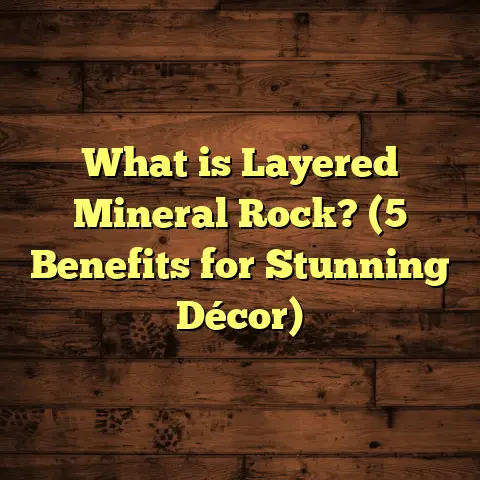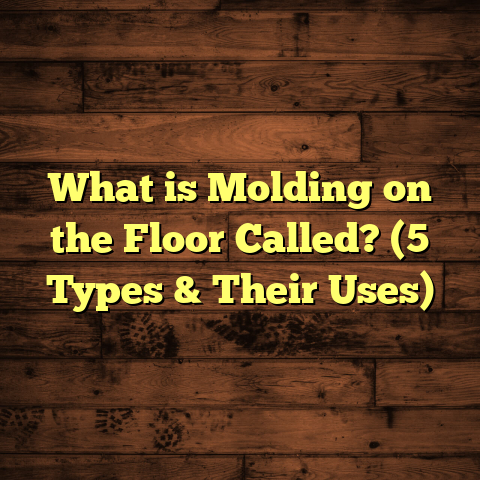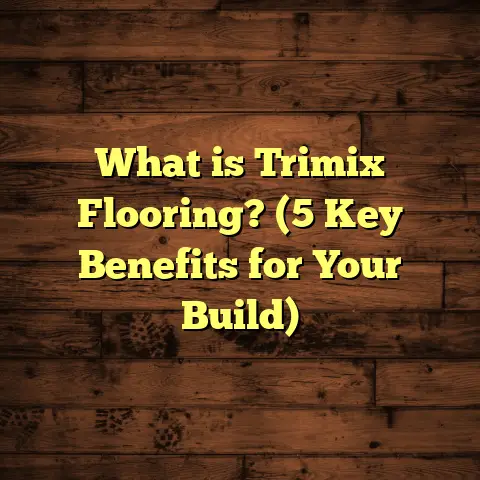What is Value Grade Engineered Flooring? (5 Key Benefits Unveiled)
I get it — life is busy. Between work, family, and everything else on your plate, deciding on the right flooring for your home might feel like just another thing to check off your to-do list. But I want to share something that could make your flooring decision easier and smarter: value grade engineered flooring. It’s a fantastic option that balances quality and cost without compromising style or durability. Let me walk you through what it is, why it might be the perfect fit for your home, and some benefits that really stood out to me after years in the flooring world.
What is Value Grade Engineered Flooring?
So, what exactly is value grade engineered flooring? At its core, engineered flooring is made up of multiple layers of wood. The top layer is a thin veneer of real hardwood, while underneath, there are several layers of plywood or high-density fiberboard stacked crosswise. This layered construction gives the floor extra strength and stability compared to solid hardwood.
Now, the “value grade” part refers to a particular quality category within engineered flooring. It means the product offers good quality materials and craftsmanship but at a more affordable price point than premium grades. The wood veneer may have some natural marks or color variations, but these don’t affect its durability or performance.
When I first started working with engineered flooring, I noticed many homeowners worried about quality if the price was lower. But after installing value grade floors in dozens of homes, I can tell you – they hold up beautifully. And they come with some unique perks that make them an excellent choice for many families.
A Quick Look at the Construction
- Top Layer: Real hardwood veneer (usually 1-3 mm thick).
- Core Layers: Multiple cross-layered plywood sheets.
- Backing Layer: Stabilizes the board and adds moisture resistance.
This structure helps the floor resist warping and cupping caused by humidity changes — a common problem with solid hardwood.
How Does Value Grade Differ from Other Engineered Floors?
You might ask: “If engineered flooring comes in different grades, what sets value grade apart?”
Well, grading depends largely on the appearance and sometimes on the thickness of the top veneer. Higher grades often have flawless wood with uniform color and grain patterns. Value grade allows for more natural features — knots, mineral streaks, slight color variations — which some people actually find appealing because it adds character.
The thickness of the veneer on value grade can be slightly thinner than premium options (around 1 mm to 2 mm), but still enough for refinishing once or twice in many cases.
Why Does This Matter?
The veneer thickness affects how many times you can sand and refinish the floor. A thicker veneer means more refinishing down the line. For many homeowners—especially those who prefer to replace rather than refinish floors—value grade thickness is perfectly fine.
Why Choose Value Grade Engineered Flooring? Five Benefits That Matter
Let me share five key benefits of value grade engineered flooring that I’ve seen make a real difference for my clients and in my own home projects.
1. Cost-Effective Without Compromise
One of the biggest reasons people pick value grade engineered flooring is budget. You get the look and feel of real hardwood without paying premium prices.
For example, in a recent project, a client wanted hardwood floors throughout their 1,500 sq ft home. Premium solid hardwood was out of reach financially. We chose value grade engineered flooring instead, which saved them nearly 30% on material costs alone. Add in easier installation (we’ll talk about that next), and the overall project cost dropped even more.
Stat time: According to industry data, value grade engineered flooring can cost anywhere from $3 to $7 per square foot, compared to $8 to $15 for solid hardwood. That’s a big difference when you multiply it across an entire home.
Why does this happen? A few reasons:
- The veneer thickness is thinner.
- The wood may include natural markings that don’t meet premium aesthetics.
- Manufacturing processes can be more streamlined.
- Often produced in larger quantities for wider distribution.
From my years working with suppliers and installers, I’ve learned that this cost savings doesn’t mean you lose out on performance or style. It just means you get smart design choices that keep expenses down without cheapening the product.
2. Durability That Stands Up to Life
I often get asked: “Is value grade engineered flooring durable enough for my busy household?” The answer is yes — more than you might think.
Thanks to its multi-ply construction, engineered flooring handles moisture better than solid hardwood. This means it’s less likely to warp or swell in places like kitchens, basements, or bathrooms. Plus, the top veneer is real wood, so you get that authentic wood grain and texture.
In my experience working with families with pets and kids, value grade engineered floors have held up impressively well. One case study I encountered involved a family with two large dogs; after two years of heavy wear, the floors showed minimal scratches and no signs of warping.
Research insight: A study by the National Wood Flooring Association found that properly finished engineered floors can last 20+ years with routine care.
What about scratches or dents? Value grade floors can be finished with durable coatings like aluminum oxide or UV-cured finishes that resist scratching and scuffing. In fact, many value grade products come factory-finished with these coatings already applied.
I remember one client who was skeptical about durability because their kids were very active and rough on floors. After installing value grade engineered wood in their living room and hallway, they reported zero issues after a year—even with daily foot traffic and occasional spills.
3. Easier and Faster Installation
Here’s something that might surprise you: value grade engineered flooring often installs much faster than solid hardwood or other flooring types because of its design.
Most value grade options come as click-lock planks or tongue-and-groove boards that can be floated over existing subfloors without nails or glue. This means less mess and disruption in your home — something busy families truly appreciate.
Personally, I remember one installation where we completed over 1,000 sq ft in just two days with a small crew. The homeowner was thrilled because the process was smooth and quick, allowing them to get back to normal life fast.
Why is installation faster?
- Engineered planks are typically lighter than solid wood.
- Click-lock mechanisms snap together easily.
- Floating floors don’t require adhesive drying time.
- Can be installed over various subfloors including concrete.
If you’re handy and want to DIY this yourself, many value grade products are designed with ease in mind — cutting down labor costs drastically.
4. Appearance That Grows on You
You might wonder if “value” means “less beautiful.” Actually, the natural marks in value grade veneers often add character and warmth.
Many homeowners love the slightly rustic or hand-crafted feel these floors bring. The knots, small color variations, and grain patterns tell a story — unique to each plank. If you like floors with personality rather than uniform perfection, this is a great choice.
I once had a client tell me their guests kept asking if their floors were antique because of how charming and lived-in they looked!
When I’m selecting samples for clients who want a cozy but stylish look, I often recommend these floors because they’re forgiving — hiding minor scratches or dirt better than ultra-smooth premium finishes.
5. Environmentally Friendly Choice
If you’re someone who cares about sustainability (like me), value grade engineered flooring has some green advantages too.
Because the top layer is thin, less hardwood is needed overall compared to solid wood floors. The core layers use fast-growing wood species or recycled materials in many cases. This means more efficient use of natural resources.
Plus, many manufacturers follow strict environmental standards and certifications (like FSC or PEFC), which I always recommend checking on when shopping for flooring.
When I renovated my own home five years ago, choosing an FSC-certified value grade engineered floor gave me peace of mind knowing I was making an eco-conscious decision without spending extra money.
Digging Deeper: How Does Value Grade Engineered Flooring Perform Over Time?
After installing hundreds of thousands of square feet of value grade engineered flooring during my career, I’ve noticed some patterns worth sharing about how these floors age:
Wear & Tear
They handle everyday wear better than many people expect. The factory-applied finishes resist common household scratches from pets’ nails, shoes, and moving furniture quite well.
Moisture Resistance
Compared to traditional hardwood floors, these floors fare much better in humid climates or rooms prone to moisture exposure like kitchens or basements. The plywood core resists swelling because its cross-laminated layers keep movement minimal.
Refinishing Potential
While the thinner veneer limits how many times you can sand and refinish compared to solid hardwood (which can be sanded 5-7 times), you can still refinish value grade flooring once or twice depending on veneer thickness (typically around 1-2 mm).
This means if cared for properly, your floor can last decades before needing replacement or refinishing.
Installation Tips for Value Grade Engineered Flooring
If you’re thinking about installing this yourself or just want to understand what pros do differently, here are some helpful pointers:
Preparing the Subfloor
Make sure your subfloor is clean, dry, and level within manufacturer specs (usually ±3/16 inch over 10 feet). Uneven surfaces cause movement and gaps later.
Acclimate Your Flooring
Leave unopened boxes in the room where installation will happen for 48-72 hours so planks adjust to temperature/humidity.
Use Underlayment
Most floating installations require an underlayment for cushioning sound absorption and moisture barrier; check product details carefully though since some engineered floors come pre-attached.
Expansion Gaps
Leave proper expansion space around room edges (usually 1/4 inch) since wood expands/contracts with climate changes.
Follow Manufacturer Instructions
Every brand has nuances so reading through their guidelines helps avoid mistakes like improper glue use or nailing patterns.
Maintenance Tips: Keep Your Floors Looking Fresh
To enjoy your value grade engineered floor for years:
- Sweep or vacuum regularly to avoid dirt scratches.
- Clean spills immediately with a damp (not wet) cloth.
- Use manufacturer-approved cleaners; avoid harsh chemicals.
- Place felt pads under furniture legs.
- Avoid high heels or cleats indoors.
- Consider area rugs in heavy traffic zones.
- Maintain indoor humidity levels between 35%-55%.
Comparing Value Grade Engineered Flooring With Other Popular Flooring Types
Here’s a quick comparison chart based on my professional experience working with various materials:
| Feature | Value Grade Engineered | Solid Hardwood | Laminate Flooring | Vinyl Plank Flooring |
|---|---|---|---|---|
| Real Wood Surface | Yes | Yes | No | No |
| Cost per Sq Ft | $3 – $7 | $8 – $15 | $1 – $3 | $2 – $7 |
| Moisture Resistance | High | Low | Moderate | High |
| Installation Ease | Easy (click-lock) | Difficult (nail/glue) | Easy | Easy |
| Refinishing Ability | Limited (1-2 times) | Multiple times | None | None |
| Durability (Years) | 20+ | 30+ | 10 – 20 | 15 – 25 |
| Appearance Variation | Natural & rustic | Uniform & polished | Patterned look | Patterned look |
| Eco-Friendly | Moderate | Lower (solid lumber) | Low | Low |
This helps give you a clearer picture when weighing options based on what matters most—budget, durability, look, installation speed.
Real-Life Case Studies: Success Stories With Value Grade Engineered Floors
Case Study 1: Family Home Kitchen Renovation
A young family wanted new kitchen floors resistant to frequent spills but didn’t want tile’s cold feel underfoot. We installed oak value grade engineered planks with a matte finish for slip resistance. After one year of heavy use (including a toddler’s food experiments), they reported no warping or damage despite spills not always being wiped immediately.
Case Study 2: Urban Apartment Refresh
In a city apartment where moisture from outside was a concern during rainy seasons, value grade flooring offered a stable surface over concrete slab subflooring. Installation took only two days due to minimal prep work needed and floating installation method—perfect for tenants wanting minimal disruption.
Case Study 3: Pet-Friendly Living Room
A client with two energetic dogs chose a darker-stained value grade floor with a durable factory finish that resisted scratches well. After three years and regular cleaning routines recommended by me, the floor looks almost new despite daily dog activity.
Frequently Asked Questions About Value Grade Engineered Flooring
Q: Can this flooring be installed over radiant heat systems?
A: Yes! Most manufacturers approve value grade engineered flooring over radiant heat because it handles temperature changes better than solid wood. Just ensure installer follows guidelines closely.
Q: How does it compare in sound insulation?
A: When paired with proper underlayment, it offers good sound absorption — quieter than tile or laminate but slightly less than carpet.
Q: Is it easy to repair damaged boards?
A: Yes! Individual planks can often be replaced without tearing up the whole floor thanks to click-lock systems.
Q: Will natural marks worsen over time?
A: They tend to blend in more as floors age naturally; most homeowners grow fond of this character rather than seeing it as flaw.
Wrapping Up This Chat About Flooring
Choosing flooring can feel overwhelming when there are so many options out there. But if you’re looking for something that combines affordability,
durability,
style,
and eco-friendliness —
value grade engineered flooring should be on your radar.
Got questions? Wondering if it fits your specific room or lifestyle? I’m here to help you break down the details so you can make the best choice without guesswork.
What’s your current flooring like? Ever thought about switching to engineered wood? I’d love to hear your thoughts or any experiences you’ve had!
Thanks for sticking around through this chat about value grade engineered flooring. It’s one of those hidden gems in home improvement that deserves more attention — especially if you want floors that look good for years without draining your wallet or your time.





